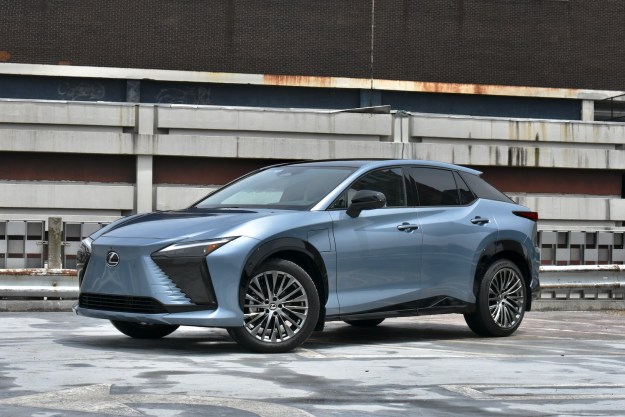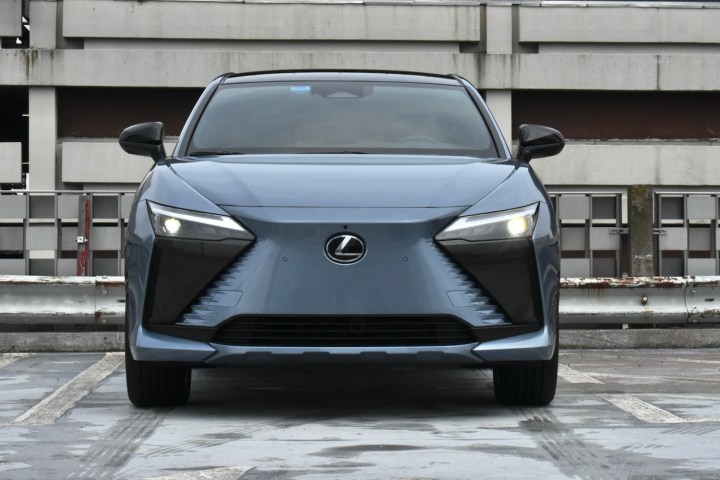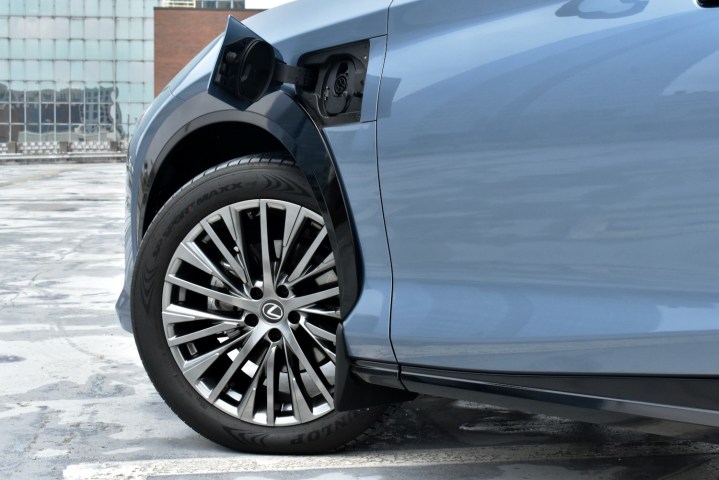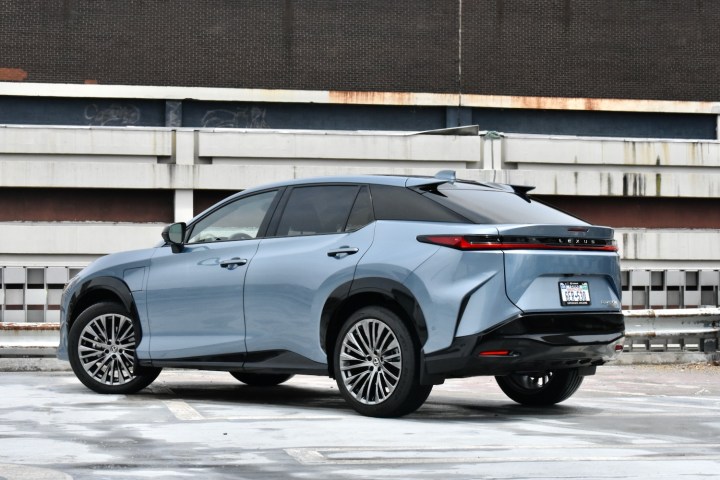
“The Lexus legacy shines bright in the luxurious RX 450e, but short range dims its appeal.”
- Better looking than other Lexus SUVs
- Solid infotainment system
- Luxurious driving experience
- Lackluster range
- Mediocre charging performance
As the luxury brand of Toyota, Lexus has been a pioneer of hybrids. It was the first luxury brand to introduce a hybrid, launching an electric-assisted version of its popular RX crossover SUV in 2005. But times change.
Having a lineup full of hybrids is no longer good enough. Lexus may have been able to ignore the popularity of Tesla among luxury-car shoppers, even as its rivals scramble to compete with the upstart automaker, but it can’t ignore stricter emissions rules. So while its signature hybrids will remain, Lexus is finally launching an EV.
The 2023 Lexus RZ 450e — or RZ for short — is the luxury brand’s first EV for North America and the first globally designed from the ground up as an EV. Like many of the best-selling Lexus models, the RZ is based on a Toyota, in this case the bZ4X, but looks different inside and out, and carries a price premium. Pricing starts at a steep $59,650 for the base Premium model. We drove the higher-level Luxury model, which rang up at $67,245 with options.
Design and interior

The RZ shares the Toyota e-TNGA platform with the aforementioned bZ4X (and the Subaru Solterra), as well as the same basic crossover SUV shape, but it’s unmistakably a Lexus. And while Lexus’ alien-looking styling cues may not be for everyone, this is one of the best executions so far.
Instead of slapping on a fake grille, designers used the headlights and surrounding trim pieces to create the outline of Lexus’ trademark “spindle grille,” keeping the family resemblance going in a more creative way. The front fenders flare out like a race car’s, while a creased element just below the window line blends them nicely into the doors. In contrast to the bZ4X, where weirdness seemed to take priority over style, the RZ is an improvement over Lexus’ gasoline crossover SUVs.
The RZ is an improvement over Lexus’ gasoline crossover SUVs.
Just as the bZ4X was designed with a footprint similar to the popular gasoline Toyota RAV4, the RZ is close in size to that model’s Lexus equivalent, the NX. That also gives the RZ a similar footprint to the Tesla Model Y, and it offers comparable first-row and second-row headroom as well. The Tesla has a slight advantage in legroom, though, and offers significantly more cargo space than the Lexus’ 23.7 cubic feet with the rear seats up and 47.9 cubic feet with the rear seats folded. Lexus doesn’t offer a frunk, either, opting to use the space under the hood to package mechanical components.
The interior is a nice place to be, with a level of thoughtfulness you don’t normally see in entry-level luxury cars. Lexus thankfully ditched the bZ4X’s blocky dashboard for a conventional design that nicely integrates the touchscreen and digital instrument cluster. The RZ doesn’t have a glovebox (the space is used for an efficiency-boosting radiant heater) but Lexus designers did a better job on the replacement storage nook, which doesn’t let items rattle around as in the bZ4X. Befitting a Lexus, interior materials were also notably more upscale. Our test car had snazzy blue suede upholstery with white leatherette trim, with an illuminated fish-scale pattern projected onto the door panels at night. And instead of the normal panoramic glass roof, the RZ’s roof can go from transparent to opaque at the push of a button.
Tech, infotainment, and driver assist

Lexus had one of the worst infotainment systems in the business, but recent models have received a major upgrade. First launched on the NX, the Lexus Interface system replaced the cumbersome Remote Touch Interface touchpad controller with a more conventional interface that relies on the touchscreen, plus natural language voice recognition similar to what BMW and Mercedes-Benz have been offering for some time.
In the RZ, Lexus Interface runs on a 14.0-inch touchscreen, paired with a digital instrument cluster of indeterminate size and an optional 10.0-inch head-up display. Wireless Apple CarPlay and Android Auto are standard, along with Wi-Fi, wireless device charging, five USB-C ports, and a cloud-based navigation system that incorporates Google points of interest. Digital key functionality and a 13-speaker Mark Levinson audio system are optional.
As with the exterior and interior design, Lexus put its best foot forward here. Just having voice recognition that can recognize casual speech is a big deal. You can switch radio stations or adjust the temperature without having to touch anything, just like in its German peers. The on-screen text is easy to read thanks to an uncluttered arrangement that takes full advantage of the screen’s size, but you still get buttons and knobs for important functions like audio volume, temperature, and camera view.
Lexus put its best foot forward with the infotainment system.
Lexus included some neat smaller touches as well. The climate-control knobs show the temperature on little displays (actually part of the touchscreen, which they’re mounted to), and manipulating the steering-wheel controls brings up a menu on the head-up display, limiting the need to look down at the instrument cluster or to the side at the touchscreen. That’s good, as we found the RZ’s driver-attention monitor to be a bit oversensitive. That, and drive-mode controls buried in a touchscreen submenu, are the only real complaints.
The typical array of driver-assist features is standard equipment, including adaptive cruise control, lane departure warning, lane keep assist, forward collision warning, automatic emergency braking (including oncoming vehicle detection), blind spot monitoring, rear cross-traffic alert, and traffic sign recognition. Proactive Driving Assist will also gently apply the brakes when it thinks you aren’t following a curve, or are getting too close to another vehicle or cyclist.
Front cross-traffic alert and a park assist system that can help maneuver the RZ in and out of perpendicular and parallel spaces are optional, as is Traffic Jam Assist. This subscription-based feature lets the car automatically creep forward in stop-and-go traffic. Blessed with a traffic-free week of driving, we didn’t have an opportunity to try it out.
Driving experience

The sole available battery pack matches the 71.4-kilowatt-hour capacity of the single-motor Toyota bZ4X, but the Lexus is available only with a dual-motor all-wheel drive powertrain, badged Direct4 by Lexus. The RZ is also more powerful than the dual-motor bZ4X. At 308 horsepower and 320 pound-feet of torque, it makes 94 hp and 72 lb-ft of torque more than the Toyota.
That added grunt allows for a Lexus-estimated zero-to-60 mph time of 5.0 seconds, making the RZ 1.5 seconds quicker than its Toyota cousin. But for similar money, you could have a Tesla Model Y Performance that hustles from zero to 60 mph in 3.5 seconds.
The one truly disappointing thing about the RZ is its range.
The RZ is still pretty quick, though, and it eschews Tesla-like theatrics for smooth acceleration that gets you up to speed without bruising any organs. Because while Lexus has built a few performance cars, the RZ seems more in line with the brand’s traditional emphasis on comfort, quiet, and luxury. The excellent chassis tuning of the bZ4X carries over, but the RZ does an even better job of absorbing bumps and silencing outside noises. The Direct4 all-wheel drive system adjusts the flow of power to the front or rear axles not only to aid traction but also to control pitch and dive, keeping the body level and reducing harsh motion.
Lexus also devised a dedicated system to blend regenerative braking with conventional hydraulic brakes for a smooth feel. While it does accomplish that, the RZ doesn’t allow for one-pedal driving, so you’ll always be using the brake pedal to some extent. The RZ does make up for that to some extent with a regeneration boost triggered by a paddle shifter, temporarily increasing deceleration in a manner similar to downshifting in a manual-transmission car.
Range, charging, and safety

The one truly disappointing thing about the RZ is its range. Models with the standard 18-inch wheels are rated at 220 miles per charge. That drops to just 196 miles with the optional 20-inch wheels. That doesn’t really cut it when a base Tesla Model Y offers 304 miles of range. A base Audi Q4 e-tron can go 265 miles on a charge, the Genesis GV60 is rated at 248 miles in its longest-range form, and the Mercedes-Benz EQB maxes out at 243 miles. It’s a reminder that this is an early effort, and Lexus hasn’t mastered EV efficiency. We saw 2.9 miles per kWh after a week of driving, while a car like the Model Y is closer to 4.0.
Lexus doesn’t make up for this lackluster range with fast charging, either. The RZ can only DC fast charge at 150 kilowatts, which can complete an 80% charge in 30 minutes in ideal conditions, according to Lexus. A full recharge using a Level 2 AC charger takes nine hours. This is average performance for an EV, but in the RZ you won’t be able to go as far after each charging session.
We don’t yet know if the RZ will have an advantage over other EVs in safety, as crash-test ratings from the National Highway Traffic Safety Administration (NHTSA) and Insurance Institute for Highway Safety (IIHS) haven’t been published yet.
Warranty coverage is the same as other Lexus models, including a four-year, 50,000-mile, basic warranty, six-year, 70,000-mile, powertrain warranty, and an eight-year, 100,000-mile warranty for the battery pack and related components.
How DT would configure this car

Checking every box for tech requires upgrading from the base Premium grade to the RZ 450e Luxury. The head-up display, park assist, and digital key are available as options on the Premium, but the high-end audio system, Traffic Jam Assist, and front cross-traffic alert are only available on the Luxury model. That’s just as well. While the Premium seems a bit pricey for a base model, the Luxury’s near-$70,000 sticker price is pretty much the norm for a well-equipped luxury SUV.
The RZ is a well-executed luxury SUV, too, hiding its Toyota DNA with distinctive styling, a plush interior, and graceful driving dynamics. However, it’s only a second-rate EV, falling short of rivals like the Audi Q4 e-tron, Genesis GV60, Mercedes-Benz EQB, and Tesla Model Y in range and charging performance. Keep in mind that the Volvo XC40 Recharge is in line for a refresh for the 2024 model year as well. The RZ also overlaps with the larger Cadillac Lyriq in price, but with deliveries proceeding slowly, it’s unclear when you will actually be able to get one.
Like the Lyriq, the RZ is one of the best products its maker has put on sale recently — electric or otherwise. It just isn’t the best choice for a road trip. For commuting, around-town driving, or as a second car, though, it’s a solid choice.
Editors' Recommendations
- Audi Q6 e-tron ushers in the automaker’s next EV phase
- Bold style alone can’t muscle Chevy’s new Blazer EV to the head of its class
- Acura’s resurrected ZDX SUV is an EV shortcut
- Ford EV drivers can use 12,000 Tesla Superchargers starting in 2024
- Mercedes-Maybach EQS SUV is old-school luxury — electrified



